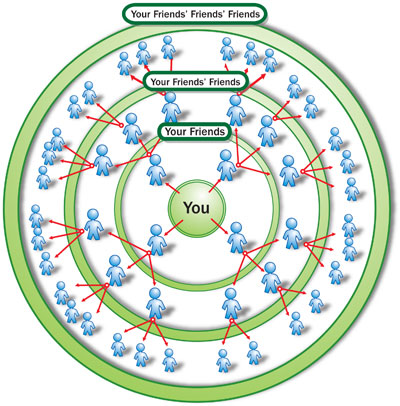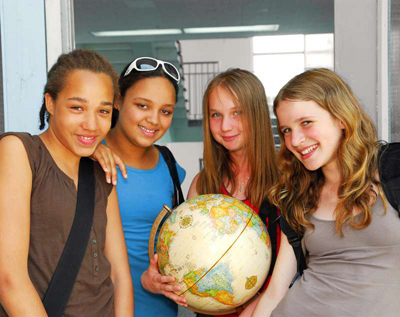What Is the Strengths Perspective in Social Work
How Social Networking Works
By: Dave Roos
Social networks are the relationships that tie us together. Think about what happens when you meet someone new. You ask where they work, where they grew up, where they went to school. Eventually, you realize that your childhood friend was in this guy's fraternity in college. Even though you've never met before, you're both part of the same social network -- a friend of a friend.

© iStockPhoto/Franz Pfluegl
Social networks allow friends to connect.
The term "social network" has been around since the 1950s, but the meteoric rise of social-networking Web sites like MySpace, Facebook and Linkedin has turned a dusty sociological phrase into the hottest buzzword of the Internet age.
A social network is a social structure that maps out the relationships between individuals. Technically we all belong to one giant social network, but we also belong to smaller, tighter social networks defined by our families, our friends, where we live, where we work, where we went to school, our hobbies and interests and much more.
Social Networks History
In the early 1930s, a self-published psychologist named Dr. Jacob Levi Moreno introduced the sociogram, the first formal attempt to map out the relationships within a group of people. Moreno's sociogram -- a cluster of individual points, or "nodes," connected by straight lines -- became a powerful tool for identifying social leaders, outsiders, and what he called the "sociometric star," the person to whom all others are connected [source: Psybernet].
In 1954, anthropologist J. A. Barnes used the phrase "social network" to describe the complex relationships in a Norwegian fishing village [source: The Bumble Bee].
If you sat down with a pen and paper, it would be difficult to map out all the people with whom you're connected and all the people with whom they're connected. That's why social-networking Web sites are so powerful.
Social-networking sites "make invisible social networks visible" by allowing us to see (with pictures and links) who our friends are, who our friends' friends are, and who our friends' friends' friends are -- all in an easy-to-use interface [source: Wireless Jobs.com].
When you create a profile on a social-networking site, you literally put yourself on the social-networking map. You can use the Web site to:
- look up old friends; make new ones
- share music, photos and videos
- join groups based on interests such as politics, hobbies or favorite TV shows
- find jobs or love; or browse for the weirdest profile picture
How popular are social-networking sites? According to ComScore, MySpace drew more than 114 million visitors ages 15 and older in June 2007, a 72 percent increase over June 2006. Facebook jumped 270 percent in the same year, up to 52 million visitors a month. According to Alexa, seven of the top 20 most visited Web sites in the world are social-networking sites, such as MySpace or Friendster, or contain significant social-networking components like YouTube or Hi5.
But as social-networking sites go mainstream, the demographics are shifting. By August 2006, more than two-thirds of MySpace visitors were over 25 years old, with more than 40 percent between the ages of 35 and 54. Now that non-university students can sign up for Facebook accounts, more than half of that site's members are out of college. [source: ComScore]
This isn't just a U.S. phenomenon. Social-networking sites have gone global. In June 2007, Google's Orkut drew 49 percent of its visitors from Latin America (mostly Brazil) and 43 percent from the Asia-Pacific region. In that same month, a full 89 percent of visitors to Friendster were from the Asia-Pacific region and 63 percent of visitors to Bebo were from Europe [source: ComScore].
In this HowStuffWorks article, we're going to explain how social networks work, how technology aids in forming and maintaining social networks, and how Web sites take social networks to the next level and beyond.
Social Networks Provide Connections
Social networks can be defined as "our connections with other people." [source: BT Technology Journal] You're connected to your friends, who in turn are connected to their friends, and so on.
Your relationship to others in the social network can be measured by degrees of separation. Your friend is one degree of separation away from you. Your friend's friend is two degrees of separation away from you, and so on.
Six Degrees?
Interestingly, the original six degrees experiment, conducted by social psychologist Stanley Milgram in the 1960s, has been criticized as an academic "urban myth." In Milgram's study, he gave a letter to random "starters" with instructions to get the envelope to its final destination by mailing it to people they know. Milgram reported that the letters arrived at their final destinations in an average of six hops [source: Psychology Today].
But according to Psychology Today, only 30 percent of Milgram's letters made it to their destination, making his findings less than reliable. But despite the faults of his original research, Milgram might have been right. In 2003, scientists from Columbia University published results of an e-mail study involving 60,000 people from 166 countries. It took an average of six hops to get a message from one stranger's inbox to another [source: Columbia University].
Social Networks as Social Capital
Social networks are important because they give us social capital. Social capital is the "resources accumulated through the relationships among people" [source: Journal of Computer-Mediated Communication]. These resources can come in several forms.
- Useful information: medical tips, driving directions, movie recommendations
- Personal relationships: family, friends, neighbors, colleagues
- Ability to organize and form groups: local government, sports teams, knitting circles
Social capital makes it easier for us to find useful information and increases a community's capacity to organize and achieve goals. Social networks can also breed negative side effects.
According to a New York Times article, Harvard Medical School researchers found that when some members of a social network gain weight, their friends are more likely to do the same [source: New York Times]. Obesity, therefore, is an example of negative social capital. Social scientists are exploring other manifestations of negative social capital, such as suicidal thoughts in teenagers and even autism.

HowStuffWorks
This diagram shows how connections happen.
There are many relationships that make up social networks, and it's natural that some people in your network will be more closely related to you than others. Sociologists identify two major types of relationships in social networks: strong ties and weak ties. Examples of strong ties could be family, close friends and immediate co-workers, while weak ties could be a childhood friend you haven't seen in 10 years, the clerk at the bookstore or a classmate with whom you don't hang out very often [source: BT Technology Journal].
We'll discuss strong and weak ties more on the next page.
Social Network as a Circle of Ties
Strong ties are harder to maintain than weak ties because they require frequent contact and more time and attention. Since strong ties require so much energy, there's a limit to how many an individual can maintain. Weak ties, on the other hand, are practically limitless, since they include people you may have met only once or know in a very specific social context (the secretary at your dentist's office, for example).

© Photographer: Jaimie Duplass | Agency: Dreamstime
Social networks allow you to create strong and weak ties.
The main advantage of weak ties is that they serve as bridges to unexplored areas of the social network. At college, for example, it's natural for your first social network to be limited to people who live in your dorm. Then, one day, the kid sitting next to you in calculus class invites you to a party at his dorm. Suddenly, this weak tie has opened up a completely new segment of the college social network.
Weak ties are also important for exposing us to "non-redundant information," meaning opinions and ideas that are outside of our circle of strong ties. This type of "novel information" could help us locate a wider range of dating possibilities or land a new job in a company we'd never heard of before [source: Journal of Computer-Mediated Communication].
There's evidence that social networks are most effective at generating social capital when they come about naturally, rather than being created. Self-made networks are called informal networks, while those imposed by an outside source -- like the bureaucracies and hierarchies in large companies -- are called formal networks.
Social psychology experiments in the 1930s first proved that workers are more productive within informal social networks. People, it seems, resent being told who to work with, where to get information and how to share it.
For businesses, that's led to a rise in "flatter" organizational structures, in which instructions don't necessarily come down from above and information works its way slowly back upward. Rather, ideas and management decisions can move up, down and sideways, with an emphasis on "peer-to-peer" collaboration.
Let's look at technology's effect on social networks, particularly its power to help us connect with and maintain even more strong and weak ties.
Technology and Social Networks
Preindustrial social networks were largely confined to geographic locations. Without an airplane, a car, a telephone or an e-mail account, people formed relationships primarily with the people who lived in their towns or villages. As transportation and communications technology improved, social networks grew larger and larger.

© Peter Vilisimaa/Photodisc/Getty Images
Technology lets us stay in touch.
E-mail, instant messaging (IM),cell phones and the Internet are some of the most powerful technologies for cultivating and maintaining larger social networks. In an era of instant communication, it's much easier to keep in touch with a wide network of both strong and weak ties. The Internet makes it possible to leap outside of your offline social network entirely, finding and connecting with people whom you would never have met otherwise.
Studies show that e-mail -- far more than phone calls -- is the most effective way to keep in touch with a large network of acquaintances. In most social networks, the larger the network becomes, the less often people communicate with each other. That's true with phone calls and in-person visits, but not with e-mail. According to a 2006 report by the Pew Internet & American Life Project, no matter how large their social network became, respondents still e-mailed an average of 20 percent of their "core" ties every week [source: Pew Internet & American Life Project].
The Internet is, by definition and function, a tremendous network. Although powered by impersonal routers, servers and computer code, it's essentially a tool for connecting people and information. The Internet knows no geographical boundaries. It enables what some researchers have termed glocalization, the free flow of information between local and global social networks. [source: apophenia]
When e-mail, IM, cell phones and the Internet work together, they empower something called networked individualism. Networked individualism is the idea that we switch back and forth between many different social networks based on the particular social capital we're seeking, whether it's advice on which car to buy, info on single women in the area, or a collaborator on a work project.
Wireless technology is key to networked individualism. Cell phones, BlackBerries and laptop computers give us greater mobility and connectivity than ever before. We can go and be wherever we want, yet we're always online.
There's no longer a need for the office- or home-based network that reaches out to the larger network. The individual floats freely through his world, joining or creating online social networks when and as he needs them. And, we do need them. In a 2004 survey, 60 million Americans said they'd used the Internet in the past two years to help make an important life decision [source: Pew Internet & American Life Project]. Examples of these decisions were:
- Helping themselves or another person with a major illness
- Changing jobs
- Moving to a new location
- Making a major financial investment
- Choosing a school for themselves or a child
The Internet has proven to be a powerful tool for searching out and engaging in various forms of social networking. But the real leap forward came with the launch of Web sites called social-networking sites whose exclusive purpose is to build and maintain social networks.
Read on to find out exactly how social-networking sites work.
Setting up Social Networking Accounts
There are three basic steps to using all social-networking sites:
- Create and post a personal profile
- Search the network for existing contacts or browse for new ones
- Add contacts to your network
Creating a Profile
To join any social-networking site, you'll first be asked to choose a login name and password. Once you're a member, you'll be asked to fill out some basic personal information, such as name, sex, age, location, hobbies/interests, etc. A lot of sites also allow you to upload a photo of yourself. This information is used to build a basic profile.

© Nicholas Kamm/AFP/Getty Images
You can decorate your profile however you like.
Most social-networking sites then allow you to further personalize your profile, either by answering more detailed questions, filling out short descriptions of yourself and your interests, or by uploading media files -- such as photos, music and video. Some social-networking sites allow you to change the way the profile page looks to make it even more unique.
Social-networking Web sites didn't come out of thin air. If you look closely, some of the Internet's most popular destinations have always included powerful social-networking components.
- Amazon's review system allows peer-to-peer book ratings.
- EBay's buyer/seller reputation system allows individuals to build loyalty and trust within the community.
- And portals like AOL, Yahoo! and MSN have always encouraged users to form online groups based upon shared interests.
There are more than 300 active social-networking sites, and each one has a slightly different process for creating a profile. However, the profile's function is always the same. It's the image of yourself that you present to the online world. This, of course, has its advantages and disadvantages.
The advantage is that online profiles give us a chance to put our best foot forward and choose to share only the parts of our lives that are the most interesting. A disadvantage is that visitors to your profile could "label" you as a one-dimensional figure -- a punk music fan, a sports fanatic, a depressed poet -- instead of a whole person.
On most social-networking sites, you can control who can view your full profile. On some sites, only "friends," or people who you've added to your network can see all the information on your profile, while others can only see your photo and some basic stats like your age and location.
On the next page, find out how to find and make connections on social networks.
Finding and Making Connections
There are three ways to find friends and make connections on social-networking sites:
- Invite your offline friends to join
- Search for friends who are already members
- Find interesting people and ask them to join

© Photographer: John Helgason | Agency: Dreamstime
You can stay in touch from any computer.
Social-networking sites allow you to send e-mails inviting friends to join the Web site and automatically become part of your online social network. Some social-networking sites, like Facebook and LinkedIn, allow you to upload your address book from Webmail accounts like Yahoo!, Gmail and AOL and send invites to all your contacts at once.
You can also make connections by searching the social-networking site for people you know who are already members. Search capabilities differ from site to site, but some ways to search for friends are by:
- the person's name, screen name or e-mail address
- high school or college affiliation
- workplace or organization
- affiliation with a certain network or group on the Web site
Once you find someone you know, you can send him a message asking them to join your social network. The invitation works both ways. If the other person accepts the invitation, you're automatically added to their social network as well. People can decline your invitation, too.
Next, we'll learn how to make connections with new and old friends.
Making Online Connections
Now that you've found everyone you know from the offline world, it's time to get into the real fun of online social networking, which is browsing for new and interesting people to contact and add to your network.

© Photographer: Aniram | Agency: Dreamstime
Meet new friends with online social-networking sites.
A good place to start is by looking through your friends' connections. On most sites, once someone has been added to your network, you have permission to view the profiles of everyone on their network. When you find an interesting person, you have several options:
- Send them an invite to join your network
- Send them a private message through the Web site to introduce yourself and say "Hi."
- Post a public message in a special place on their profile
After you've exhausted your friend's connections, you can start looking for people who have similar hobbies and interests. Social-networking sites allow people to easily create or join groups built around a theme. The possibilities are literally endless. There are groups for bicycle enthusiasts: bicycle enthusiasts in Belfast, unicycle enthusiasts in Belfast, unicycle enthusiasts in Belfast who like breakfast, and so on.
Most social-networking sites allow you to view at least partial profiles of all of the members of a group. When you find someone interesting, make contact. It's that simple.
Sites like MySpace allow you to browse the entire site for new contacts using criteria such as:
- Age, sex, location
- What types of relationships the person is looking for (dating, friends, networking)
- Smoker, drinker, sexual orientation
- Only profiles with photos
Many social-networking sites also allow you to search by keyword or tags. Tags are user-created keywords that can be attached to any piece of content -- a photo, a message board post, a video, a Web page -- that allows people to know more about it. On a photo-sharing site like Flickr, for example, it's possible to search by tags such as "cat," "music" and "sunset."
If you find a tagged video, photo or message board post that you like, you can follow the link to the user's profile, find out more about them (and their friends) and even ask them to join your network.
Building a network of friends and contacts is a lot of fun, but that's only the beginning. Read on to find out more about what people do on social-networking sites and why they're so powerful.
What Social-networking Sites Do
Different social-networking sites promote different types of interactions and activities. To understand why people use social-networking sites, it's helpful to first break down these sites into some general categories.
Community Social-networking Sites
This is a broad term for any social-networking site whose purpose is to help users identify and enlarge their social networks by searching for existing contacts and finding new ones.

© Photographer: Elena Elisseeva | Agency: Dreamstime
Social-networking sites bring together friends from all around the world.
Some of these community sites aim for a particular demographic: LinkedIn attracts working professionals; the original Facebook stuck to college kids; Black Planet, Asian Avenue and Mi Gente target racial and ethnic affiliations. But other sites, like MySpace, Yahoo 360 and Hi5 are general community sites in which users can form smaller groups based on interests or demographics.
Media Sharing Sites
These are sites where the main activities are uploading photos and videos and viewing other user's photos and videos. You don't have to be a member of the site to look at other people's pictures and movies, but you have to join to upload your own.
Once you've joined, you can invite other users to be your friend, at which point they'll be added to your page as links with profile photos. YouTube is the most popular video-sharing site and Flickr is one of the best-known photo-sharing sites. We should mention that many of the general community sites include media-sharing elements, like the ability to post pictures, videos and music on personal profiles.
Social Bookmarking Sites
Bookmarking is the practice of saving a link to a Web site in your Web browser. Social bookmarking, on the other hand, is saving that same link to a special social bookmarking Web site where other people can see what you're bookmarking.
When you save a link to a social bookmarking Web site, you tag it with as many keywords as you like. Other people can look up bookmarks by tags, or they can browse by the most popular or most recent bookmarks.
If you like the kind of links someone else is collecting, you can add that person to your network and receive notifications when they add a new bookmark. Examples of popular social bookmarking sites are del.icio.us, Digg and Furl.
Blogging Social Networks
These are social-networking sites, which bring together individuals and their blogs. Instead of a simple profile, each user keeps a running Weblog on topics of their choice. Sites like Livejournal, Blogger and Xanga allow users to search and browse for interesting blogs. When you find a kindred spirit, add his blog to your list of friends. You can form communities with other bloggers.
Music Social Networks
Sites like Pandora, Last.Fm and iLike are a new breed of social-networking sites based on sharing music with friends. Pandora and Last.Fm work like streaming radio stations. You enter an artist name and the Web site creates a play list of songs that it thinks you'll like. You can play the full list in your browser and even rate the songs so that the Web site gets to know your tastes better. You can share your play lists and favorite songs with "friends" who are part of your network.
Many of the more than 300 social-networking sites fall outside these five categories. But no matter the specific audience or goal of a social-networking site, they can all be powerful social-networking tools by strengthening our connections.
Find out more about how social-networking sites are bridges to friendship.
Social Networks as Bridges
Researchers see social-networking sites as effective mechanisms for "maintaining" and "bridging" social capital [source: Journal of Computer-Mediated Communication].

© Photographer: Jaimie Duplass | Agency: Dreamstime
Social-networking sites let friends stay in touch.
Social-networking sites help users "maintain" social capital by supporting existing offline relationships. For example, when a kid graduates from high school and goes to college, he's physically separated from his high school social network. But if his friends sign up for Facebook accounts, they can keep tabs on what everybody's doing.
Because of its original college focus, Facebook isn't necessarily representative of all social-networking sites. But research into how people use Facebook supports the idea that the site is important for maintaining the social capital from existing relationships.
When asked who they think is the audience for their Facebook profile, a survey group of college students came up with the following list, ranked from most likely audience to least likely:
- High school friends
- People in my classes
- Other friends
- Total strangers at same college
- Someone I met at a party
- Family
Other than "total strangers at same college," the other top five members of the Facebook audience are existing contacts from the offline world, some of them strong ties (high school friends, family) [source: Journal of Computer-Mediated Communication].
Social-networking sites increase our capacity to form weak ties. On a social-networking site, you can add "friends" who like the same band, even though you know nothing else about them. It's not uncommon for frequent users of online social networks to have hundreds or thousands of "friends."
Some of these weak ties serve as "bridges" to other social networks and other types of social capital. An example of how bridging social capital works could be:
- You search for Portland gardens on photo-sharing site Flickr.
- You find some beautiful pictures of petunias from a user named Garden_geek.
- You invite Garden_geek to be your "friend."
- He sends you an e-mail inviting you to a local Portland gardening club.
- Garden_geek, a weak tie, has served as a bridge to new friends and new information about gardening -- more social capital!
Social-networking sites make invisible social networks visible by publicly displaying our connections to other people. According to researcher Danah Boyd, these public displays serve multiple purposes:
- We infer things about a person's political views, musical tastes and personality by seeing who his friends are.
- It's a way to establish trust. Example: If you know Sam, then you must be cool.
- It's a way to confirm identity. By listing hundreds of friends, you're saying that these people know me, therefore I must exist.
Future of Social-networking Sites
Social-networking sites are expanding rapidly to accommodate new users and adding new features daily, so it's difficult to say what the future holds.
Large corporations and organizations are tapping into the power of online social networking by adding social-networking components to their existing Web sites. Nike, for example, launched a community site called Joga to bring together soccer lovers from around the world. The idea is to build brand awareness and loyalty by creating an online destination where people want to hang out.
Another emerging trend is to "build your own" social network. Web sites like Ning and Me.com allow anyone to create or join stand-alone social networks built around specific themes or interests. Companies can use these sites to build social networks around their brand, or individuals can build more tightly focused communities than on the larger social-networking sites.
For lots more information about social networks and related topics, check out the links on the next page.
Lots More Information
Games
Advertisement
What Is the Strengths Perspective in Social Work
Source: https://money.howstuffworks.com/business-communications/how-social-networks-work.htm
0 Response to "What Is the Strengths Perspective in Social Work"
Post a Comment